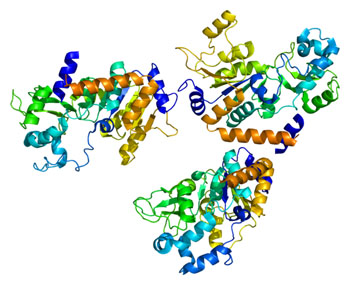Researchers Describe Aggressive Breast Cancer Molecular Mechanism
|
By LabMedica International staff writers Posted on 11 Nov 2016 |

Image: The structural model of the SIRT2 protein (Photo courtesy of Wikimedia Commons).
Cancer researchers have found that SIRT2, a member of the sirtuin family of enzymes, stabilizes Slug, a transcription factor that promotes the development, growth, and spread of basal-like breast cancer.
Overabundance of Slug protein is common in human cancer and represents an important determinant underlying the aggressiveness of basal-like breast cancer (BLBC). Despite its importance, this transcription factor is rarely mutated in BLBC, and the mechanism of its deregulation in cancer remains unknown.
To better understand the link between Slug and BLBC, investigators at Tufts University School of Medicine (Boston, MA, USA) screened BLBC cultures for factors that would stabilize Slug activity.
They reported in the October 25, 2016, online edition of the journal Cell Reports that Slug underwent acetylation-dependent protein degradation and identified the deacetylase SIRT2 as a key mediator of this post-translational mechanism. SIRT2 inhibition rapidly destabilized Slug, whereas SIRT2 overexpression extended Slug stability. SIRT2 deacetylated Slug protein at lysine residue K116 to prevent Slug degradation.
SIRT2 was frequently amplified and highly expressed in BLBC. Genetic depletion and pharmacological inactivation of SIRT2 in BLBC cells reversed Slug stabilization, caused the loss of clinically relevant pathological features of BLBC, and inhibited tumor growth. Without SIRT2, tumor cells had a more than 60% reduction in invasive capacity compared to normal basal-like tumor cells. SIRT2-depleted cells also had significantly decreased capacity for growth and self-renewal. This diminished malignancy could be reversed by artificially introducing Slug protein back into cells.
"Breast cancer is not one disease, and of the several distinct subtypes, basal-like breast cancer represents the most aggressive form. By targeting a master transcription factor regulator in basal-like cells, we were able to reduce malignant behaviors," said senior author Dr. Charlotte Kuperwasser, professor of developmental, molecular, and chemical biology at Tufts University School of Medicine. "Our findings now provide a molecular rationale for new approaches to help improve the poor clinical outcomes currently associated with these cancers."
"Cancer cells find sophisticated ways to regulate essential proteins they need for their survival and growth. The transcriptional factor Slug is one such protein and is often tightly regulated in both normal and cancer cells. While we have found that SIRT2 plays an important role in prolonging Slug expression, it is too soon to know whether targeting SIRT2 will be sufficient to abolish Slug entirely in cancer cells and therefore lead to tumor regression," said Dr. Kuperwasser. "A significant amount of work remains to be done before we can verify if targeting SIRT2 can be an Achilles' heel for treating basal-like breast cancers."
Related Links:
Tufts University School of Medicine
Overabundance of Slug protein is common in human cancer and represents an important determinant underlying the aggressiveness of basal-like breast cancer (BLBC). Despite its importance, this transcription factor is rarely mutated in BLBC, and the mechanism of its deregulation in cancer remains unknown.
To better understand the link between Slug and BLBC, investigators at Tufts University School of Medicine (Boston, MA, USA) screened BLBC cultures for factors that would stabilize Slug activity.
They reported in the October 25, 2016, online edition of the journal Cell Reports that Slug underwent acetylation-dependent protein degradation and identified the deacetylase SIRT2 as a key mediator of this post-translational mechanism. SIRT2 inhibition rapidly destabilized Slug, whereas SIRT2 overexpression extended Slug stability. SIRT2 deacetylated Slug protein at lysine residue K116 to prevent Slug degradation.
SIRT2 was frequently amplified and highly expressed in BLBC. Genetic depletion and pharmacological inactivation of SIRT2 in BLBC cells reversed Slug stabilization, caused the loss of clinically relevant pathological features of BLBC, and inhibited tumor growth. Without SIRT2, tumor cells had a more than 60% reduction in invasive capacity compared to normal basal-like tumor cells. SIRT2-depleted cells also had significantly decreased capacity for growth and self-renewal. This diminished malignancy could be reversed by artificially introducing Slug protein back into cells.
"Breast cancer is not one disease, and of the several distinct subtypes, basal-like breast cancer represents the most aggressive form. By targeting a master transcription factor regulator in basal-like cells, we were able to reduce malignant behaviors," said senior author Dr. Charlotte Kuperwasser, professor of developmental, molecular, and chemical biology at Tufts University School of Medicine. "Our findings now provide a molecular rationale for new approaches to help improve the poor clinical outcomes currently associated with these cancers."
"Cancer cells find sophisticated ways to regulate essential proteins they need for their survival and growth. The transcriptional factor Slug is one such protein and is often tightly regulated in both normal and cancer cells. While we have found that SIRT2 plays an important role in prolonging Slug expression, it is too soon to know whether targeting SIRT2 will be sufficient to abolish Slug entirely in cancer cells and therefore lead to tumor regression," said Dr. Kuperwasser. "A significant amount of work remains to be done before we can verify if targeting SIRT2 can be an Achilles' heel for treating basal-like breast cancers."
Related Links:
Tufts University School of Medicine
Latest BioResearch News
- Genome Analysis Predicts Likelihood of Neurodisability in Oxygen-Deprived Newborns
- Gene Panel Predicts Disease Progession for Patients with B-cell Lymphoma
- New Method Simplifies Preparation of Tumor Genomic DNA Libraries
- New Tool Developed for Diagnosis of Chronic HBV Infection
- Panel of Genetic Loci Accurately Predicts Risk of Developing Gout
- Disrupted TGFB Signaling Linked to Increased Cancer-Related Bacteria
- Gene Fusion Protein Proposed as Prostate Cancer Biomarker
- NIV Test to Diagnose and Monitor Vascular Complications in Diabetes
- Semen Exosome MicroRNA Proves Biomarker for Prostate Cancer
- Genetic Loci Link Plasma Lipid Levels to CVD Risk
- Newly Identified Gene Network Aids in Early Diagnosis of Autism Spectrum Disorder
- Link Confirmed between Living in Poverty and Developing Diseases
- Genomic Study Identifies Kidney Disease Loci in Type I Diabetes Patients
- Liquid Biopsy More Effective for Analyzing Tumor Drug Resistance Mutations
- New Liquid Biopsy Assay Reveals Host-Pathogen Interactions
- Method Developed for Enriching Trophoblast Population in Samples
Channels
Clinical Chemistry
view channel
POC Breath Diagnostic System to Detect Pneumonia-Causing Pathogens
Pseudomonas aeruginosa is a major cause of hospital-acquired and ventilator-associated pneumonia, particularly in lung transplant recipients and patients with structural lung disease. Its ability to form... Read more
Online Tool Detects Drug Exposure Directly from Patient Samples
Doctors often rely on patient interviews and medical records to determine what medications a person has taken, but this information is frequently incomplete. People may forget drugs they used, take over-the-counter... Read moreMolecular Diagnostics
view channel
Rapid Diagnostic Breakthrough Simultaneously Detects Resistance and Virulence in Klebsiella Pneumoniae
Antibiotic resistance is a steadily escalating threat to global healthcare, making common infections harder to treat and increasing the risk of severe complications. One of the most concerning pathogens... Read more
DNA Detection Platform Enables Real-Time Molecular Detection
A next-gen DNA detection platform enables real-time molecular detection by detecting nucleic acids directly without enzymes or thermocyclers, thereby slashing costs, reducing complexity, and boosting reliability... Read moreHematology
view channel
MRD Tests Could Predict Survival in Leukemia Patients
Acute myeloid leukemia is an aggressive blood cancer that disrupts normal blood cell production and often relapses even after intensive treatment. Clinicians currently lack early, reliable markers to predict... Read more
Platelet Activity Blood Test in Middle Age Could Identify Early Alzheimer’s Risk
Early detection of Alzheimer’s disease remains one of the biggest unmet needs in neurology, particularly because the biological changes underlying the disorder begin decades before memory symptoms appear.... Read more
Microvesicles Measurement Could Detect Vascular Injury in Sickle Cell Disease Patients
Assessing disease severity in sickle cell disease (SCD) remains challenging, especially when trying to predict hemolysis, vascular injury, and risk of complications such as vaso-occlusive crises.... Read more
ADLM’s New Coagulation Testing Guidance to Improve Care for Patients on Blood Thinners
Direct oral anticoagulants (DOACs) are one of the most common types of blood thinners. Patients take them to prevent a host of complications that could arise from blood clotting, including stroke, deep... Read moreImmunology
view channel
Blood Test Could Identify Colon Cancer Patients to Benefit from NSAIDs
Colon cancer remains a major cause of cancer-related illness, with many patients facing relapse even after surgery and chemotherapy. Up to 40% of people with stage III disease experience recurrence, highlighting... Read moreBlood Test Could Detect Adverse Immunotherapy Effects
Immune checkpoint inhibitors have transformed cancer treatment, but they can also trigger serious immune-related adverse events that damage healthy organs and may become life-threatening if not detected early.... Read moreMicrobiology
view channel
Breakthroughs in Microbial Analysis to Enhance Disease Prediction
Microorganisms shape human health, ecosystems, and the planet’s climate, yet identifying them and understanding how they are related remains a major scientific challenge. Even with modern DNA sequencing,... Read more
Blood-Based Diagnostic Method Could Identify Pediatric LRTIs
Lower-respiratory tract infections (LRTIs) are a leading cause of illness and death worldwide, and pneumonia is the leading infectious cause of death in children under five, claiming the lives of over... Read morePathology
view channel
Rapid Low-Cost Tests Can Prevent Child Deaths from Contaminated Medicinal Syrups
Medicinal syrups contaminated with toxic chemicals have caused the deaths of hundreds of children worldwide, exposing a critical gap in how these products are tested before reaching patients.... Read more
Tumor Signals in Saliva and Blood Enable Non-Invasive Monitoring of Head and Neck Cancer
Head and neck cancers are among the most aggressive malignancies worldwide, with nearly 900,000 new cases diagnosed each year. Monitoring these cancers for recurrence or relapse typically relies on tissue... Read more
Common Health Issues Can Influence New Blood Tests for Alzheimer’s Disease
Blood-based tests for Alzheimer’s disease are transforming diagnosis by offering a simpler alternative to spinal taps and brain imaging. However, many people evaluated at memory clinics also live with... Read more
Blood Test Formula Identifies Chronic Liver Disease Patients with Higher Cancer Risk
Chronic liver disease affects millions worldwide and can progress silently to hepatocellular carcinoma (HCC), one of the deadliest cancers globally. While surveillance guidelines exist for patients with... Read moreTechnology
view channel
Machine Learning Models Diagnose ALS Earlier Through Blood Biomarkers
Amyotrophic lateral sclerosis (ALS) is a rapidly progressive neurodegenerative disease that is notoriously difficult to diagnose in its early stages. Early symptoms often overlap with other neurological... Read more
Artificial Intelligence Model Could Accelerate Rare Disease Diagnosis
Identifying which genetic variants actually cause disease remains one of the biggest challenges in genomic medicine. Each person carries tens of thousands of DNA changes, yet only a few meaningfully alter... Read moreIndustry
view channel
BD and Penn Institute Collaborate to Advance Immunotherapy through Flow Cytometry
BD (Becton, Dickinson and Company, Franklin Lakes, NJ, USA) has entered into a strategic collaboration with the Institute for Immunology and Immune Health (I3H, Philadelphia, PA, USA) at the University... Read more









 assay.jpg)












